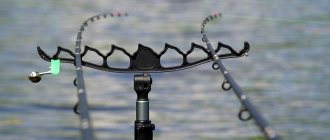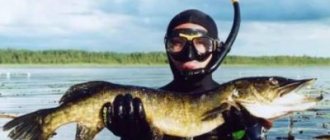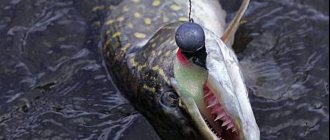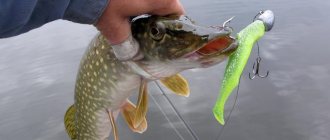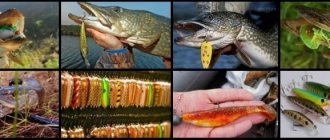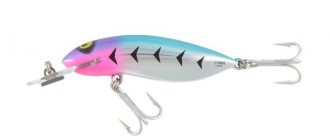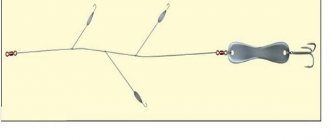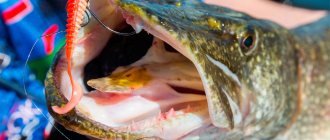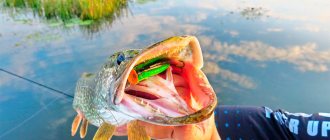Yuri 12/16/2020 239
I quite often come across anglers, both amateurs and professionals, who underestimate the role of hooking. Most people don’t even think about how to hook fish on a spinning rod correctly, but in vain. It is because of this that freshwater inhabitants often get off the hook, thereby causing complete disappointment.
I’ll tell you how to hook pike perch and pike on a spinning rod, as well as other predators so that they don’t get off the hook. We will also look at the most common mistakes made by spinners.
Is this even important to know?
Of course, real experts know how to hook fish with a spinning rod, how to do it competently, and they don’t even have any doubts that this process is the basic element in hunting a predator. Hooking ensures a rigid fixation of the fish on the hook. In most cases, the fixation ensures that the lace or excellent specimen is lifted onto the shore or into the boat. Finding the right moment to hook is not difficult. The main thing here is not to hesitate and immediately start catching your prey.
- Important! A deterioration in the bite usually occurs when the water drops; activation or deactivation can also be affected by a change in weather.
If the fish behaves quite passively in the reservoir, then the moment of biting will not be so clearly noticeable, however, you will understand everything. Is it necessary to hook at this moment? Of course yes! The main thing here is not to hesitate and act tactfully, without scaring the fish.
- Interesting! When fishing by trolling, fish are able to hook on their own, but for control it is better to hook the trophy.
In order to fish professionally and never experience fish jumping off the hook, it is important to know how to properly hook fish on a spinning rod.
Equipment Features
When fishing is successful, there are no difficulties. The quivertip twitches, moves to the side - and the fisherman takes the fish out of the reservoir. However, in feeder fishing there are many special moments, failure to comply with which leads to unrealized bites, broken leads or the disappearance of fish at the beginning of fishing. The technique for biting and retrieving is based on the features of the feeder equipment and depends on the nuances of installation, fishing conditions and fish behavior. It is impossible to take all these factors into account in theory. The system develops for each fisherman individually in the process of gaining experience. Here we will look at obvious points that will help novice feeders and, perhaps, add something to the knowledge of experienced fishermen. Read more about feeder equipment.
Features every fisherman should know about
I cannot give clear recommendations on this issue, since the process is influenced by many factors. But one of them lurks precisely at the tip of the rod. For example, if I go hunting for bass, I need a tackle that is not too long, but with the most sensitive tip. For such toothy predators as pike and pike perch, it is better to choose a stiffer whip, since they have more powerful jaws than the same perch.
But still, getting off the hook most often occurs precisely because of illiterate hooking. The spinner needs to do everything without delay and avoid common mistakes.
To minimize all risks, it is recommended not to pull the fish like “a bull by the horns,” but rather, to tire it out with your actions. If you don’t know how to hook a pike on a spinning rod, do everything as follows:
- carefully;
- quickly, but without unnecessary emotions and panic.
It is also important to pull out the fish, so I recommend preparing a landing net and other equipment in advance.
How to hook a pike on a spinning rod and get it out of the water
Often, not only novice fishermen, but also experienced amateurs underestimate the role of hooking predatory fish, in particular pike, but in vain. It is from incorrect hooking that pike often come off the hook, causing considerable disappointment.
How the technique is performed correctly and what is the best way to take the robber will be discussed below. We will look at the main mistakes of a spinning angler and reveal the secrets of properly fishing for pike.
Common mistakes made by spinners
Of course, there are many reasons why a fish comes off the hook, but sometimes the fault lies on the shoulders of the fisherman, since he simply did not know how to properly hook a pike on a spinning rod. Therefore, I will tell you about the most common mistakes that you should never make:
- weak, untimely hooking, when the predator’s mouth is not broken;
- fishing line hanging down;
- the fish went into hiding and found itself in its own comfort zone, where it is not difficult for it to jump off the hook;
- use of low-quality hooks;
- hunting a predator without using a steel leash;
- attempts to throw the prey ashore with a jerk of the spinning rod.
Accordingly, I recommend immediately remembering all the mistakes and how to hook correctly with a spinning rod. Thanks to this, you already increase the chances of catching a predator by at least 50%. And to be confident in effective fishing, the only correct advice is to practice more. Go fishing in Sazanya Bay more often, and hunting for predators will be a joy for you!
For me, catching pike with spinning gear is a real thrill. I get an incredible amount of emotion from fighting a predator.
TAGS:
Beware of the candle
Often the pike escapes by jumping out of the water with its head up: by shaking its muzzle, it can get rid of the hooks. If the hook is caught on the edge of the mouth, there will be no candle; it only happens when the hooks are deep in the gills, but it is not a fact that they are firmly entrenched there. If the angle of the line suddenly sharpens, it means the fish has gone up sharply and wait for a candle.
There are two ways to escape this. If you have a light spinning rod, a thin line, a mini bait, and the fish is solid, lower the rod and throw a couple of turns from the reel, give it some slack and then, perhaps, the low inertia of the mass of the bait will not allow the predator to get rid of the hooks .
If the gear is reliable and the bait is heavy, keep the line taut, lower the rod tip as low as possible to the water and do not let the pike jump out. If she jumps out, splash her down as quickly and sharply as possible.
Tags
Carp Buffalo Spring Vobla Asp Winter Crucian Rudd Summer Fishing baits Lower Volga Perch Autumn Fisherman's reminder Lures Bite forecast Fishing in Astrakhan Fishing baits Fishing tackle Fishing secrets Catfish Fishing methods Pike perch Catch Pike
Correct fishing for pike
Many people, after hooking a fish, have one thought in their heads: how to pull it in order to minimize the likelihood of it disappearing. It's simple. The main thing to do when fishing with a spinning rod is to control the tension of the cord. With the correct tension, the likelihood of a fish coming off is minimized. This is a tandem of well-coordinated work between a rod and a reel, or rather its clutch. The fish can approach, go deeper, or lead into the grass. Don't rush, let it get tired, don't pull it like a bull, using brute force, you need to tire the fish by releasing the line. Get an adrenaline rush from the sound of a working clutch.
Remember, if a small-sized pike lands on a hook: grass or string, you need to perform vigorous fishing and force events. If you feel that you have caught a test specimen, or have caught a big pike, haste can only do harm. It is necessary to act:
- carefully;
- do not rush;
- constantly monitor the reel brake;
- as well as the tension of the fishing line or cord.
Fishing with a spinning rod on silicone baits with a Texas rig and a light jig (part 1)
In this article, I would like to focus on catching predatory fish using modern silicone baits that appeared on our market several years ago, using methods such as Texas rigging and light jigs.
Let's look at when we need to use this or that installation, and also consider several options for suitable spinning rods. Why are we considering silicone baits that have recently appeared? The thing is that previously, when catching small predatory fish, we were limited to such baits as twisters and vibrotails, and we simply did not have another alternative, namely in the geometry of small baits. Of course, foreign manufacturers aimed at bass fishing produced silicone baits of various shapes, but their sizes usually started from 3-4 inches and they were not suitable for all our fish.
Over time, the most talented anglers have “acclimatized” these silicone lures for pike and zander. When catching perch, this rubber did not show noticeable results - striped ones were caught starting from 300 gr.
Now there are many companies on the market that provide small silicone baits 1.5–2.5 inches long in various shapes, tastes and buoyancy, which allow you to catch a wide variety of predators. These characteristics of silicone are important; below we will analyze in detail in what cases they are useful and how to fish with them.
About 8 years ago, in a fishing store, I came across an unusual silicone bait. It measured just over 2 inches and had a body shape similar to the modern Gary Yamamoto Hula Grub, with fringe at the front of the body and a double twister tail at the back. The silicone bait was from some American company, half of whose assortment is aimed at catching crappie and other small things. Out of curiosity, I purchased several of these baits. Having equipped them with small Cheburashkas and doubles, I caught perch very well in one reservoir.
The fish weren’t capricious that day; they bit quite well on a jig weighing up to 12 grams with a twister, but there were quite a lot of small fish weighing 70–100 grams. When I replaced the bait with this American miracle, the small things in the catch became significantly smaller; perches from 150 grams began to be caught. The perch stayed in the bottom layer of water, so the bait had to be moved in small jerks along the bottom and a little higher. The silicone bait created more noticeable vibrations, collected more perch and seduced larger ones, but I soon ran out of them, and nothing similar came across in stores, and for about 5 years I again fished with the usual twisters and vibrating tails.
After that, I came across a 2-inch silicone crustacean from Relax and on subsequent fishing trips it significantly increased the perch catch. That day I went to the nearest water area, where the perch responded best to the minnow. But this time the perch was slow, it only accompanied the bait and very rarely grabbed it with its lips. I have already encountered such behavior of perch here. I placed a bait suitable for these conditions (ZipBaits Ridge 56S), and began to move it in frequent single jerks with a short pause, during which the bait turned from left to right. The perch did not have time to look at it and accompany it; as a result, the perch did not “hang”, but attacked the bait as soon as it was in the zone of its grip.
My catch had increased slightly, but was still not up to the pond standard. Then I placed this crustacean on a weka rig and began throwing it into small windows among the water lilies, to snags and under overhanging bushes. By taking a long pause so that the silicone bait sank closer to the bottom and slightly supporting it with a spinning rod, I achieved greedy bites from the perch. The perch quickly emerged from the ambush, grabbed the crustacean with a blow and immediately rushed back to the shelter.
After several such fishing trips, it became clear that the crustacean, mounted on a light jig head or on a hook in the wacky style, strongly provokes the perch; it notices it from afar due to the strong disturbance of the water with all its legs, claws and other limbs. And even if the perch does not want to eat, he will try the bait out of irritation or curiosity; in any case, either the first or second option will work. In addition, small crustaceans are more accessible food for perch than fry, and perch grab them much more often.
Oddly enough, the reaction and bites of a perch on bulk silicone baits are often similar to its bites on cranks or spinners, that is, the perch grabs it immediately when it appears in the zone of its possible attack. Of course, the fishing technique is the opposite of this active search fishing, here we have a leisurely, more bottom-based retrieve near some bushes of algae, stones or steps of swimming pools, after the perch misses another bait, that is, where we are sure of the presence of a predator, however The reaction of less activated fish to bait is almost identical.
If for some reason the perch bites better in the water column or it is problematic to catch from the bottom due to hooks or the presence of thread, then it is better to put a worm on a weki, twister or vibrotail on a jig head instead of a crustacean. After all, crayfish swim very rarely in the water column and because of this they lose to these baits in such conditions.
Unfortunately, this crustacean has neither aroma nor “edible” properties, and to prevent the perch from spitting out the bait, it has to be lubricated with an attractant, but at one of the last exhibitions at the All-Russian Exhibition Center many different crustaceans, worms and other imitations appeared, about 2- inch size, taste and smell. This length of silicone bait is well suited for catching small perch, but at the same time it can seduce larger fish.
Let's discuss a little the concept of “edible silicone”. Currently there is:
Regular silicone bait
Ordinary silicone bait - A bait that does not have any aroma or any flavoring additives in the plastic composition. It is more often used during fast retrieval, where the fish has no time to sniff out the bait, when the fish bites well, when fishing in places with frequent hooks. They are less often caught with it, as the only one suitable in terms of its properties - game, size, shape, and this also applies to any silicone baits in general.
For example, edible inch twisters are still practically not found, or to catch the largest perches we need a large bait, but we don’t have one made from edible rubber at hand. Perch sometimes prefers the slowest retrieve, and a bait with a thin, well-playing tail will catch better than an edible, but rougher one. Or a ribbed, plump worm will cause more bites than a smooth, thin one.
There can be many examples, the main thing is to figure out whether the fish will actually bite better on this inedible or edible silicone bait than on another. In cases where ordinary silicone is the only one that works, and the bite still gets worse, you can use flavorings; the bait will be more edible, but this solution will still be optimal.
Edible “taste” silicone baits
Edible “flavored” silicone baits - This is silicone, which contains various additives (salt, garlic, chemicals), but without flavorings. When the bait gets into the mouth of a predator, these additives affect its taste buds, making it seem to it that it has caught natural prey. He begins to chew it or simply hold it in his mouth, which gives us additional time to notice the bite or wait time for an effective hook.
The disadvantage of these silicone baits is that the fish must taste it, that is, grab it with its mouth, and if it accompanies the bait without attacks, then bites will not be achieved. This rubber is good in cases where the bites are of a furtive nature, the predator plays more with the bait, tugging at its tip or biting it slightly. Having tasted it a little, he does not let it go and after a pause swallows it. A striking example of such silicone on our market is the Gary Yamamoto brand.
Silicone lures with scent
Silicone baits with smell - These are baits with various attractants, but do not have flavoring additives. Fragrances can be part of the silicone or applied to its surface in an oily liquid form. Getting into the water, these particles affect the sense of smell of a nearby predator, the smell reminds him of the naturalness of the prey and makes the picky one peck.
I use such silicone baits when a predator is interested in the bait, follows it, but does not want to attack or bite it, so in this case there will be few bites for the “flavoring” rubber, it simply will not end up in the fish’s mouth and will not work. And with a slow retrieve with pauses, the fish has time to sniff out the bait, and confident bites appear.
You should hook almost immediately after it, otherwise the predator may have time to spit out the bait. It should also be remembered that the oil in which the attractant is located is sooner or later washed off from the bait, especially quickly in warm water, so you need to periodically reapply it to the bait or put it in its original bag. For the same reasons, the bag with unused baits must be kept tightly closed, otherwise the oil will dry out and the aroma will disappear. If it becomes clear that baits with attractants bite better today, you can experiment with different scents to find out which one will get more bites today.
Edible silicone baits, with taste and smell
Edible silicone baits, with taste and smell - These are baits that contain both attractants and flavoring substances, the most universal, they have all the advantages and properties of the previously discussed silicone. All active substances can be found both in the bait material itself and in the oily substance in which it is stored, so after use we put the silicone away in its original packaging.
Until recently, there were only a few brands of such rubber, but now there are many more of them, for example Megabass, Reins, Keitech, Ecogear, Homonculures from Pontoon21, as well as the still little-known here, but very catchy Tsunekichi. Such silicone baits are used in competitions or fishing, when time is short, there is no time to experiment, but you need to catch.
Despite the fact that this article is about edible rubber, do not make this property of silicone a priority when choosing the catchable bait you need today. First pay attention to the shape, size, game and color of the bait, and only if these parameters turn out to be equally suitable for regular and edible silicone, then choose edible.
Pulling out of the water using additional means
Athletes and experienced fishermen often take prey in jerks. Beginners to the fishing community are advised to catch predatory fish using available means. Common and popular additional tools today include:
Let's look at how to use these means.
How to catch a pike with a landing net
It is necessary to learn the basic rule of how to pull out a pike with a landing net. Bring your prey into the landing net with the rod, and not vice versa. Remember that a landing net is not a butterfly net; work with a “stick”. Any fisherman should have this effective tool. With the help of a landing net you can catch almost any fish without harming it. But they also take pike with their hands. Read below to see how this is done.
How to pick up a pike with your hands
You can select prey with your bare hands after it has become exhausted and has stopped resisting. Often the predator senses the proximity of the shore and fights for its life with redoubled energy. If you grip incorrectly, you can injure the fish and damage expensive equipment.
It is considered the safest to grab the pike by the gills. It is not recommended to place your fingers under the gill covers. There is a high probability of cutting yourself on them. To avoid injuring the fish, do not grab it by the eyes with two fingers and put pressure on them. After such a “procedure,” the unfortunate patient has no chance of survival, and thus it is difficult to restrain the predator.
How to take linden for flu
In fishing stores or local markets you can find many devices for controlling and effectively catching predatory fish. Unfortunately, many of them do not meet modern requirements for safe trophy lifting. But a lip grip does not fall into the category of useless accessories. With the help of a fashionable aid, the fish is easily removed from the water. At the same time, there is no injury, which is important. They are simply a pleasure to work with. The clamp is applied to the pike's lip, and it migrates into the strong arms of the happy fisherman. Experts advise looking at how it works on the Internet before purchasing a clamp.
Using a gaff
Beginners can work with a hook. It will be especially useful for winter fishing. It is almost impossible to get a pike out of a hole any other way.
Finally
Catching pike with a spinning rod is a pleasure. To get positive emotions from fighting a predator, you need to know and follow certain rules: hook it in time, control the tension of the cord and fish for the trophy correctly. And also, go out on the water more often (if possible). After all, only practical experience gives you a chance to cope with an obstinate and strong opponent like the pike, good luck!
Sources:
https://zen.yandex.ru/media/id/5c57ab8bea64bc00ac1eb81b/5ca2cba3d92e0900b4479854 https://zen.yandex.ru/media/id/5c57ab8bea64bc00ac1eb81b/5ccc7f717e88ed00b4f1109e https://iarybak.ru/sh huka/kak-podsekat-na- spinning

